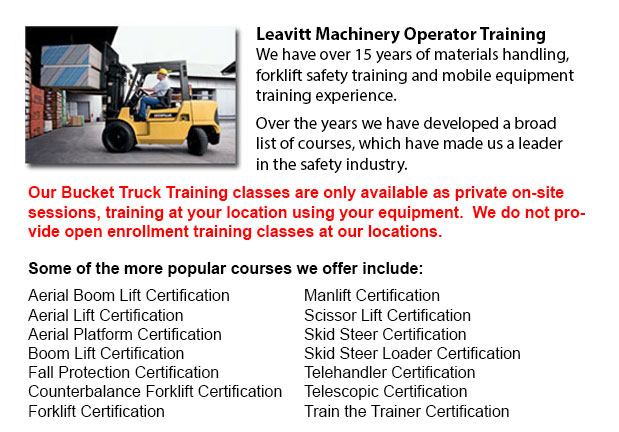
Warehouse Forklift Safety Training Saskatchewan - Companies often face liability for damage and injuries sustained in workplace accidents. Warehouses could be hazardous places to the individuals who work there. That is why employee safety is a top priority for a lot of businesses. Warehouse safety training is amongst the most effective methods to protect staff, while minimizing expenses connected with accidents and injuries.
Warehouses hold stock that can present various dangers, particularly related to materials handling. Moving stock, either manually or using powered equipment, could cause injuries to employees' fingers, hands, feet and toes. Tripping, falling and slipping are common causes of injury. Heavy things can fall off shelves and harm employees. Forklifts and other equipment carry inherent hazards as they manipulate heavily laden pallets. Wrong lifting is a common source of back injuries. Even box cutters, nails and splinters could cause harm.
Warehouse conditions can change from one moment to the next, depending on the materials or substances being handling, the tasks being done and the equipment being utilized. Due to the wide variety of potential dangers in warehouse settings, warehouse operations are regulated by many various standards. There are regulations for material handling and storage, for working and walking surfaces, and regulations governing the selection and use of PPE (personal protective equipment).
The majority of the safety rules covered by a company would consist of common sense rules. Rules which warehouse employees should be quite familiar with include:
1. If working in a warehouse, safety is a priority at all times.
2. When work calls for correct PPE, such as gloves, safety shoes, eye protection and hard hats, they should be worn.
3. Check for hazards and correct them or report them.
4. Observe and Follow warning signals and signs.
5. Pay attention to the job you are performing.
6. Pay attention to the work that others are doing nearby, particularly when they are working with forklifts and various dangerous machinery.
7. Make sure that stacked products and materials are stable and secured.
Following good housekeeping regulations will help to ensure a safe warehouse for all employees. Essential housekeeping rules involve keeping aisles and floors clear of things, like for example wires and cords. Never perch objects insecurely on a surface. When spills occur, clean up immediately. Throw garbage in right containers. Keep fire extinguisher, sprinklers and fire exits accessible. Put box cutters and other sharp tools away soon after use. Report tripping hazards like for example loose or damaged flooring.
-
Forklift Ticket Saskatchewan
Forklift Ticket Saskatchewan - Pallet jacks and forklifts are both meant for basically the same purpose; to move supplies from one location of your warehouse to another. This is pretty much where the comparison stops however. With the pallet jack, th... More -
Loader Ticket Saskatchewan
Loader Ticket Saskatchewan - Gehl articulated loaders have been made to suit practically any condition. They provide great traction and optimal maneuverability due to a heavy-duty oscillating joint that offers forty five degree rotating angles left a... More -
Forklift Training Programs Saskatchewan
Forklift Training Programs Saskatchewan - Are you searching for work as a forklift driver? Our regulatory-compliant mobile equipment operator training provides instruction in kinds of forklifts, pre-shift check, fuel kinds and handling of fuels, and... More -
Heavy Equipment Operator Classes Saskatchewan
Heavy Equipment Operator Classes Saskatchewan - A heavy equipment operator is an individual who has received the right training in order to operate a particular kind or piece of machinery. There are lots of ways for the operator to undergo training a... More -
Telehandler Training in Saskatchewan
Telescopic handlers usually known as telehandlers for short, are an extremely popular piece of heavy construction equipment. They are usually utilized in the construction and agricultural trades. These equipments have farthest reaching capacity and a... More -
Narrow Aisle Forklift / Order Picker Training / Electric Pallet Jack / Electric Pallet Truck Training in Saskatchewan
A pallet lift is a piece of equipment dedicated in the transporting of pallets of various dimensions and weights. They can be utilized as an attachment for forklifts, cranes and other types of heavy machinery or be applied on their own. Pallet lifts... More -
Operator Safety Training, Re-Qualification Training, In-House Instructor Training in Saskatchewan
Used in just about all industrial construction sites, warehouse operations or boat yards, the lift truck is a very important component so as to help pick up and transfer supplies. The reach feature of a forklift can help improve the applications whic... More -
Aerial Lift Ticket Saskatchewan
Aerial Lift Ticket Saskatchewan - Boom vehicle are often used by phone, cable and utilities firms as they have extended folded arms which are generally folded over the roofs of business vehicles. On the end of the extension of extendable arms usually... More

Forklift Training Saskatchewan
TOLL FREE: 1-888-254-6157
Saskatoon, Saskatchewan
forklifttrainingsaskatchewan.com
Email Us
About Us



